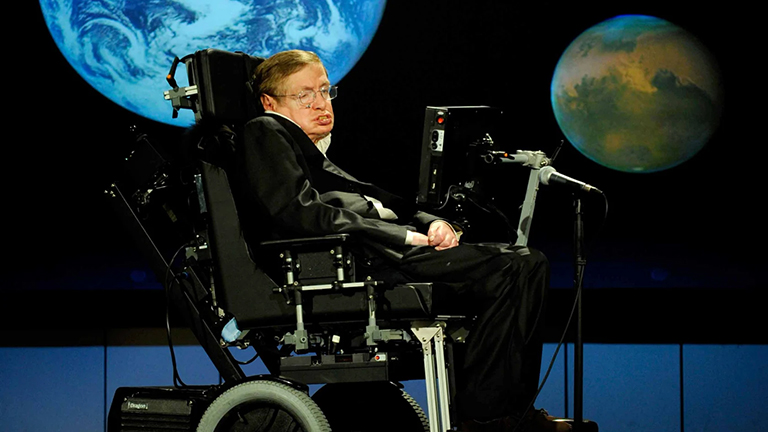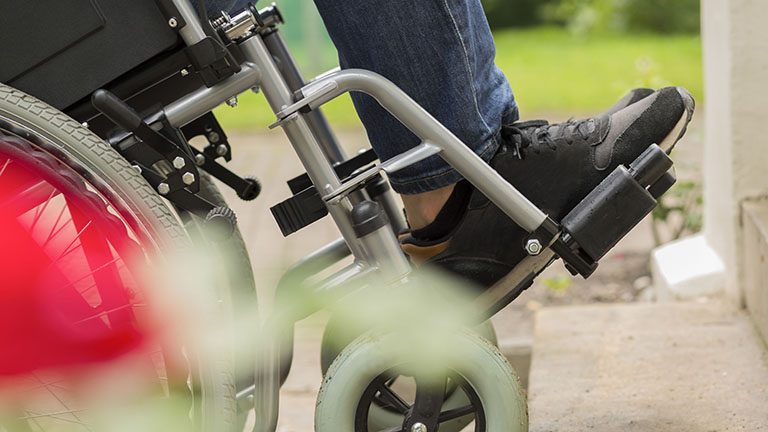In 1975, Bob Hall made history in his wheelchair after crossing the Boston Marathon’s finish line in 2 hours, 58 minutes. Hall’s achievement marks the official founding of the Boston Marathon’s Push-Rim divisions, and the first wheelchair division included in such a race.
In recognition of Hall’s pioneering spirit, we’re celebrating 10 individuals with disabilities who have let nothing hold them back on their way to change the world forever:
Wheelchair Racers
Marcel Hug – Nicknamed the “Silver Bullet” for his distinctive chrome helmet, Hug is a 31-year-old professional competitor from Switzerland. Born with spina bifida, Hug won his first junior race at the age of ten and never looked back, eventually joining the Wheelchair Sport Switzerland Athletics Team and the Swiss National Team.
Hug holds several world record times in multiple races and has won almost 30 medals. This year, Hug set another world record at the Boston Marathon with a 1:18:03 completion time. Incidentally, this year was Hug’s third straight Men’s Push-Rim division victory at the Boston Marathon.
Manuela Schär – Schär is a 32-year-old professional competitor and Paralympian who has won 14 medals throughout the Paralympic Games, IPC World Championships, and the IPC European Championships. The Swiss-born athlete suffered a spinal injury due to an accident in 1993, and discovered wheelchair racing shortly after. Since then, Schär has traveled the world and competed widely, winning medals and setting records.
This year, Schär crossed the Boston Marathon finish line with a 1:28:16 Women’s Push-Rim record time, shattering the previous record established by Wakako Tsuchida, as well as beating out Tayana McFadden, the four-time defending champion.
READ: Team USA and College Adaptive Athletics
Actor
Michael J. Fox – Possibly best known for his early roles in “Family Ties” and the Back to the Future trilogy, Fox has starred in more than a dozen Hollywood films and numerous television roles since 1976. Fox was diagnosed with young-onset Parkinson’s disease in 1991 at the age of 30 and continued to act full-time for almost a decade. However, Fox announced his retirement in 2000, at which time he launched the Michael J. Fox Foundation for Parkinson’s Research. Since that time, Fox’s foundation has become the largest funder of Parkinson’s medication development in the world.
After discovering a mixture of medication that allowed him to control his disease to a necessary degree, Fox announced his return to full-time acting in 2012, and has since appeared as the lead role in several shows, including “The Michael J. Fox Show,” and “The Good Wife.” In addition, Fox has voiced several characters in animated films, such as Homeward Bound, and Atlantis: the Lost Empire.
Author
Christy Brown – The 10th child of 22 born to a working class family in Dublin, Ireland, author Christy Brown wrote by typing with the little toe of his left foot. Brown was born with cerebral palsy, which left him largely unable to move or speak with the exception of the little toe on his left foot.
Best known for his autobiography “My Left Foot,” which was made into a Hollywood film in 1989, his other notable works include “A Promising Career,” “Wild Grow the Lilies,” as well as “Down All the Days,” which was translated into 14 languages.
Surfer
Bruno Hansen – Hansen became paralyzed from the waist down at age 27 as the victim of a failed car hijacking in Cape Town, South Africa. After the incident, Hansen was plunged into a deep depression for the next six years. However, despite the injury, Hansen found himself again in the water.
Now a 2-time World Adaptive Surfing Champion, Hansen relearned to sail, surf, dive, and spearfish independently. He acquired a small boat, working as a fisherman for a year before trading the boat for a catamaran. Hansen and a friend refurbished the catamaran over the course of a month and set out on a yearlong adventure fishing, diving, and treasure hunting, which took him from the coast of South Africa to Thailand, where he survived the 2004 tsunami. Today, Hansen spends most of his time in Panama laying the groundwork for a “seahab,” a facility to teach disabled individuals to surf, sail, dive, and discover how the ocean can be a place to realign the mind and body.
Swimmer
Trischa Zorn – The most decorated Paralympian in history, Zorn is a retired Paralympic swimmer with 55 medals (41 of which are gold). She was inducted as the first American woman into the Visa Paralympic Hall of Fame in 2012, despite the fact that she was born with aniridia, a congenital, genetic condition affecting the eyes and, as a result, has been legally blind since birth.
Zorn’s disability never slowed her down. She was ranked number one in every swimming category in which she competed from 1980 until 1992, when one of her teammates won the gold. After obtaining degrees from both the University of Nebraska and Indiana-Purdue in Indianapolis, Zorn now teaches inner-city kids with disabilities, hoping to inspire them to achieve their potential.
Archer
Matthew Stutzman – As a child, Stutzman was strongly encouraged to live without limitations. As a result, he has taught himself to play guitar, drive, hunt, fish, and, of course, use a bow, all with his feet. Having a difficult time affording groceries, Stutzman took up archery for hunting as a way to help support his family. Less than three years later, Stutzman was competing professionally.
Known as the “Armless Archer,” Stutzman was born without arms. However, such a challenge has not stopped Stutzman from competing in numerous archery competitions, including two Paralympic appearances: London in 2012 and Rio de Janeiro in 2016. In addition, Stutzman has set two world records for the longest accurate archery shot, and has recently declared for the able-bodied archery category in order to compete for a World Cup.
Adventurer
Erik Weihenmayer – Weihenmayer was stricken with juvenile retinoschisis and became completely blind at age 13. In his teenage years, Weihenmayer fought against his disability, refusing to learn braille or to use a cane. However, after falling down a flight of stairs and onto his head, Weihenmayer came to terms with his blindness. Nevertheless, Weihenmayer’s acceptance of his condition did not hinder his momentum.
Weihenmayer discovered his talent for rock climbing and was inspired to let nothing hold him back. Today, Weihenmayer is 45 and continues to add inspiring deeds to his already impressive résumé. Not only is he the only blind man to have summited Mount Everest, but Weihenmayer has also kayaked 277 miles through Class IV rapids to traverse the Grand Canyon, as well as climbed the 3,000-foot Nose route on Yosemite’s El Capitan. Weihenmayer also rode Colorado’s “Leadville 100” mountain bike race with a tandem pilot in less than 12 hours. In addition, Weihenmayer gives presentations about conquering fears and not letting a disability hold one back from doing something they love.
Scientist
Dr. Stephen Hawking –Theoretical Physicist and Director of Research at the Department of Applied Mathematics and Theoretical Physics at Cambridge, Dr. Hawking has become one of humanity’s best known and respected figures. Diagnosed with Motor Neuron Disease, a form of Amyotrophic Lateral Sclerosis (ALS) while in his early college graduate years, Hawking was predicted by doctors to have two years to live. Depressed and frustrated, Hawking had given up on his studies when, encouraged by his academic supervisor, friends, and family, Hawking returned to his work.
As a result, Hawking’s work has provided humanity with an understanding of black holes, gravitational singularities, as well as cosmic inflation. This research has been integral to our ability to understand and explore past the confines of our own planet and given answers to fundamental questions about life. In addition to such contributions, Hawking has become a role model to many others living with ALS and other debilitations.
READ: 5 Most Accessible Universities in the U.S.
Senator
Tammy Duckworth – A United States Democratic Senator from Illinois, Duckworth is an active proponent of veteran rights, student rights, immigrant rights, and worker rights. However, Duckworth lost both of her legs and sustained severe damage to her right arm when the Black Hawk helicopter she was piloting was struck by an RPG during a deployment to Iraq in 2004.
Despite the severity of her injuries, Duckworth has completed several marathons, continues to fly as a civilian, and has completed a Ph.D. in Human Services. In addition, Duckworth currently serves on several committees in the U.S. Senate, including the Environmental & Public Works Committee, the Energy & Natural Resources Committee, as well as the Small Business & Entrepreneurship Committee.



